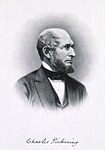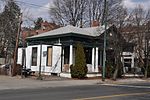Mount Auburn Cemetery

Mount Auburn Cemetery is the first rural, or garden, cemetery in the United States, located on the line between Cambridge and Watertown in Middlesex County, Massachusetts, 4 miles (6.4 km) west of Boston. It is the burial site of many prominent Boston Brahmins, as well as being a National Historic Landmark. Dedicated in 1831 and set with classical monuments in a rolling landscaped terrain, it marked a distinct break with Colonial-era burying grounds and church-affiliated graveyards. The appearance of this type of landscape coincides with the rising popularity of the term "cemetery," derived from the Greek for "a sleeping place," instead of graveyard. This language and outlook eclipsed the previous harsh view of death and the afterlife embodied by old graveyards and church burial plots.The 174-acre (70 ha) cemetery is important both for its historical aspects and for its role as an arboretum. It is Watertown's largest contiguous open space and extends into Cambridge to the east, adjacent to the Cambridge City Cemetery and Sand Banks Cemetery. It was designated a National Historic Landmark District in 2003 for its pioneering role in 19th-century cemetery development.
Excerpt from the Wikipedia article Mount Auburn Cemetery (License: CC BY-SA 3.0, Authors, Images).Mount Auburn Cemetery
Citron Avenue,
Geographical coordinates (GPS) Address External links Nearby Places Show on map
Geographical coordinates (GPS)
| Latitude | Longitude |
|---|---|
| N 42.371111111111 ° | E -71.144722222222 ° |
Address
Mount Auburn Cemetery
Citron Avenue
02134
Massachusetts, United States
Open on Google Maps










